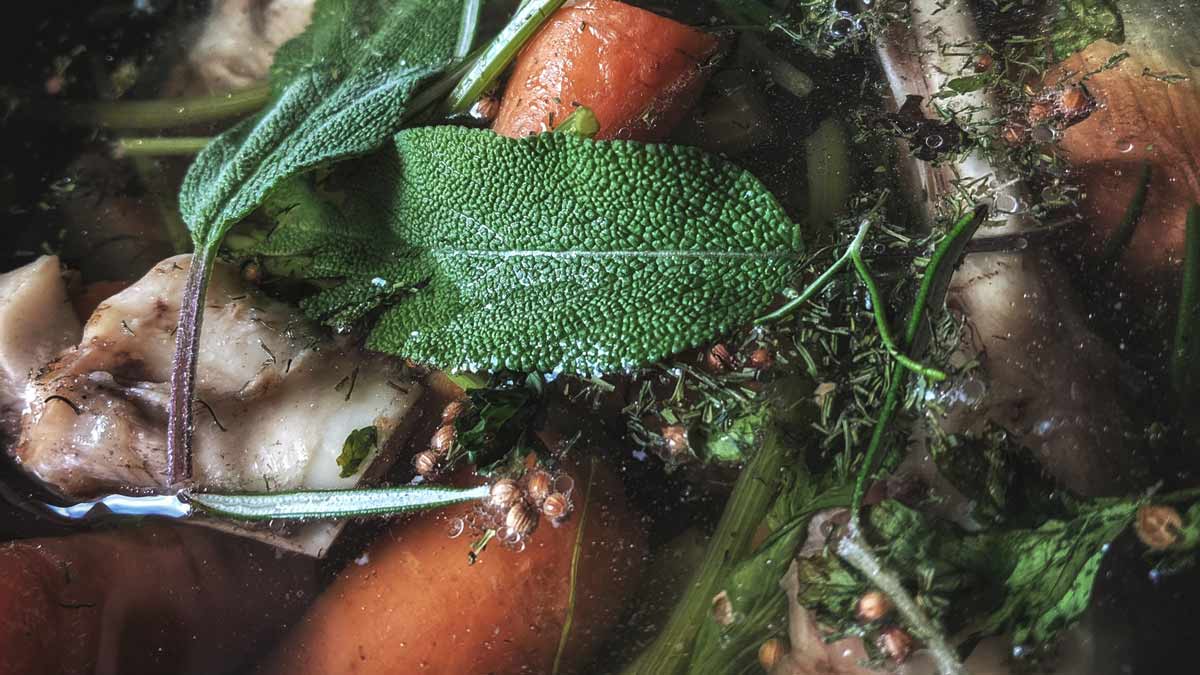Bone Broth
FOOD

Bone broth has long been a secret both of fine restaurant kitchens and food therapists, but in the last few years it has become easy to find in food markets, restaurants, and even take-out places that specialize in chef-made broths. Bone broth has now come into the spotlight.
Is it a Paleo drink? Hardly. Do we really have to discuss the plausibility of prehistoric hunters cooking bones for two days, fighting off scavengers, patiently waiting for their broth, discussing how to skim foam or when to add aromatics, all tens of thousands of years before the invention of the first cooking pot?
In the dietary branch of Chinese Medicine, cooking bones into stock is a method to extract the essence of the animal for easiest digestion and assimilation. There is something shamanic about it; we are trying to absorb the deepest digestible energy of the animal. High cuisine chefs rely on stocks for finesse and depth, but the focus in dietary therapy is on the deep resonance between the bone essence of a long-cooked stock and our own deepest level: bones, joints, blood building marrow, kidneys, reproductive system and the very special organ that resides surrounded by bone, the brain.
That’s the theory, but does it do anything in practice? I’ll leave the studies to others, but in my experience, bone stocks are extremely helpful for individuals who are depleted or run down from stressful lifestyles, overexertion, poor diet, sleep problems, specific illnesses or old age. Drinking good bone stock is grounding, fortifying, and stimulating all at the same time.
Making bone stock at home is easy, but it’s not for the fainthearted. There are bones in there, and the best stock is made from knuckles, knees, tendons… there’s no getting around it. This may not be paleolithic, but it certainly is primal.
According to the classical teachings of Chinese Medicine, each type of bone stock has a different influence within us:
- Beef bone broth: strengthens our constitutional health and is very anchoring.
- Chicken stock: stimulates our immune response and is more warming.
- Turkey and duck stock: somewhere in between.
- Fish bone broth: often forgotten but is fantastic as both a cooking stock and a health tonic, resonating with the skeletal and reproductive level. Fish bone stock cooks more quickly (fish bones are softer and quite skinny); 6-8 hours is ideal, but even one hour will make a good fish bone broth, useful for sipping or as a base for other cooking.
- Shellfish: offers a wide variety to work with: lobster and crab shell (more stimulating or warming, for adrenal exhaustion), or oyster and clam shell (more calming or cooling, for emotional stress).
Although not bones, broth made from dried scallops, mussels, shrimp, abalone and other shellfish are also common and important, particularly in Asian cuisine. Shellfish are constantly in the process of creating their shells and are therefore seen as particularly supportive to our own bone maintenance level. All of these stocks provide minerals, including calcium. Vegetarian stocks can also be made. To make a vegetarian stock that approximates a bone broth, use seaweed (usually kombu/kelp) and dried mushrooms. These vegetarian foods resonate at the constitutional level. I make vegetarian stocks often, for sipping or as a soup base, and they’re ready in only 20 minutes.
Stock recipes are personal. They have been the secret of the kitchen, and rightly so. These stocks reach deeply within us, and the constitutional level of our own health is private, it’s hidden, it is the reservoir of life’s mysteries. In the kitchen, what lurks beneath the surface of an ever-so-slightly gurgling stock pot is mysterious, like what lurks below the surface of the sea. It’s always a surprise when you see something pop up from under the surface. But the mysterious quality of bone stock is not based on the recipes being secret, rather, it’s the mysterious level at which they work within us. This is not diminished at all by sharing the recipe. Below is my recipe for basic beef bone broth, rich enough with vegetables and kitchen herbs to be called a soup.
If this is all it takes to be an urbane caveman, I’m in.
Beef Bone Broth Recipe
Serves: 4-8 quarts (depending on pot capacity)
Prep time: 30 minutes
Total time: two days
Ingredients:
fresh or frozen beef knee bones | 3-5 pounds
leek | 1 large or 2 small, white part and some green, chunked
carrots | 3 or more, medium, chunked
celery | 2-3 stalks, trimmed and coarsely chopped
olive oil | 1-2 Tbsp
salt | 1-3 Tbsp
vinegar (apple cider vinegar, red wine vinegar, or balsamic) | 1/4 cup
dried mushrooms (black or porcini) | 6-8 whole mushrooms, 1-2 ounces if porcini (or combine)
kombu | 2 strips
bay leaf | 2
seed spices | 1 tsp each of mustard seed, black peppercorns, fenugreek seed; 1/2 tsp allspice, 3-5 star anise pods, 6 green cardamom pods
other kitchen herbs | 6 red jujube dates, 1/2 handful goji berries, peel from 1/2 tangerine or mandarin orange (omit if not available)
water | 4-8 quarts, depending upon your pot size
Shopping Note: Buy knee and ankle bones from a good butcher shop. They will quarter them with a table saw to allow best cooking. Marrow bones are a delicacy for some but avoid them for making broth. We are looking for the collagen in the bone joints, not the marrow of the long bones.
Directions
Roast the bones on a baking sheet in 350˚F oven for 20-30 minutes.
While bones are roasting, coarsely chop the leek, carrot, celery and any other root vegetable that you may have ready for the stock pot (try daikon, parsnip, etc.) Toss the vegetables into the largest pot you have, add the olive oil, start them over medium-high heat with a good pinch of salt. Add the dried mushrooms and the kombu strips. Add the seeds spices and kitchen herbs. Use aromatic spices but avoid hot peppers or garlic; those spices are too stimulating to be used here for best health. Bone broth resonates with our deepest level of health, a level that deserves the cook’s respectful support and should not be overly stimulated.
When the bones have browned, move them from the oven to the stock pot (discard the fat they give off). Cover with plenty of water (your pot should be about 3/4 full of water). Bring to a simmer but not a full boil—boiling can turn the broth cloudy and slightly bitter. The stock should have a slow-rising bubble every few seconds, no more.
Add the vinegar (I often include two or three types of vinegar to add complexity). The acidity of vinegar draws calcium and collagen from the bones into the broth. The finished broth will not be acidic.
Simmer, partially covered for one or two days, non-stop. I often let bone stock cook for two and a half days. Check periodically that it is hot enough for an occasional bubble but not hot enough to reach a true boil. Too cool won’t extract essence from the bones and could at least potentially allow some bacteria to grow; too hot and the stock isn’t of the highest quality. Add water if needed.
After a day or two, pour the stock through a strainer into another pot, and discard the bones, vegetables and herbs. When cool enough, ladle the strained broth into refrigerator containers; refrigerate overnight. Fat will separate to the top for easy removal and the stock will show its character by congealing through the natural gelatin from the bones. Some may wish to reserve the beef fat for other uses, but fat is not needed in the bone broth itself—it’s the essence from bones and vegetables rendered through the cooking process that we’re after.
Warm portions in a saucepan to use. Some people like to sip bone broth straight, others like to open its taste by diluting it with some warm water. Salt to taste as desired. For superbly nourishing cooking, use beef bone stock as the foundation for soups, braise dishes, sauces and stews. For the home cook, the addition of a great stock is the secret you need to match fine restaurant cooking.
Andrew Sterman is author of Welcoming Food: Diet as Medicine for Home Cooks and Other Healers, available Fall 2019. He sees patients in New York City for Chinese medicine dietary therapy, medical qigong and meditation. Mr Sterman began studying cooking in 1988 at the Natural Gourmet Cookery School and at the same time entered Chinese medicine through qigong and tai chi. In order to deepen his understanding of food energetics, in 2001 Mr Sterman began formal study of Chinese herbal medicine, diagnostics, medical theory, and dietary therapy with Daoist master Jeffrey Yuen. Mr Sterman writes a regular dietary column for the Golden Flower Chinese Herbs newsletter. In addition to his extensive travel schedule, Mr Sterman teaches food theory and practical home cooking in Manhattan, where he lives with his family.
